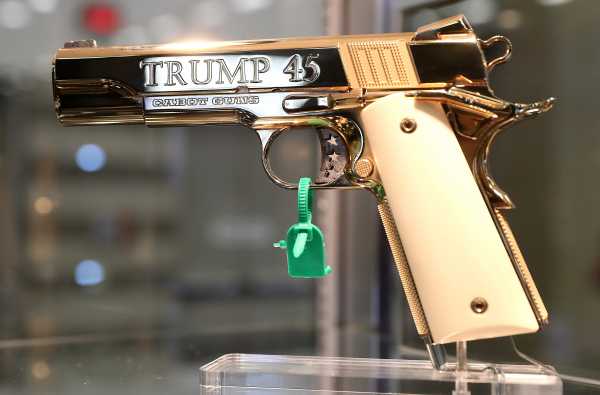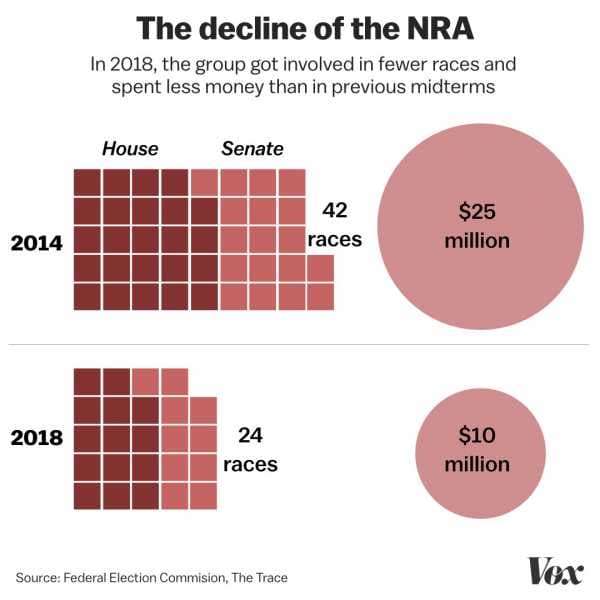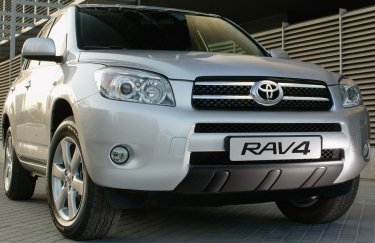
National Rifle Association CEO Wayne LaPierre bragged at the beginning of 2017, “We have the next eight years alongside President Trump to undo the Obama transformation of America and set our country back on its rightful, righteous course of freedom.”
But nearly two years later, things haven’t exactly gone according to plan for the nation’s largest and most powerful gun rights organization.
A particularly low point came during the 2018 midterm elections, when the NRA was outspent by gun control groups for the first time in recent history, even while allegedly coordinating with GOP candidates in two states.
The NRA has also been enveloped in a Department of Justice investigation into Russian efforts to influence US politics that featured Russian nationals using the organization as a conduit to the Republican Party. It’s been decried for paying millions of dollars to contractors and close associates of the organization while laying off dozens of employees. And that doesn’t even mention that between January 2017 and November 2018, two of the NRA’s biggest legislative initiatives resulted in failure — derailed by high-profile mass shootings.
Join the Vox Video Lab
Go behind the scenes. Chat with creators. Support Vox video. Become a member of the Vox Video Lab on YouTube today. (Heads up: You might be asked to sign in to Google first.)
The NRA did not respond to multiple requests for comment.
To be sure, the NRA specifically and gun owner rights more broadly are still a powerful force in politics. The organization, by its own estimation, has roughly 5 million members and says it still has hundreds of millions of dollars at its disposal. But in many ways, the election of Donald Trump has coincided with the precipitous decline of what was once the most fearsome lobbying group in Washington.
For the NRA, the Obama administration provided what any organization needs: a motivating threat. But now that threat, however existent or nonexistent it may have been, is gone, replaced by an unreliable ally in Trump. Furthermore, the organization has been so successful in changing not only America’s gun laws but the gun conversation more broadly (and what potential restrictions on guns are even floated as possibilities) that the NRA isn’t thinking big anymore — because it doesn’t have to.
The NRA suffered a series of legislative defeats in a Republican-controlled Congress — in part because of horrific mass shootings
In concrete terms, there was perhaps no better time for the NRA to flex its political muscle than January 2017, with Trump safely ensconced in the White House and Republicans in charge of both the House and Senate. During the 2016 election cycle, the group spent $30.3 million to get Trump into office, with millions more spent on six Republicans running in competitive Senate races in 2016. In North Carolina, Sen. Richard Burr’s campaign received $6.2 million, the most the group had ever spent on a down-ballot race.
Yet with the “wind at their backs,” as one source told me, the group was unable to get its major legislative priorities — the expansion of concealed carry and a change to laws restricting gun silencers — passed while Republicans had full control of Washington in 2017 and 2018.
Their top target was to win concealed carry reciprocity — making it so anyone with a concealed carry permit could use their permit (and thus their concealed weapon) in any state with concealed carry laws in place. They also sought to end restrictions on gun silencers (more accurately known as “suppressors”) by changing federal laws on devices that can be attached to a gun’s muzzle to lessen the sound of a shot.
Both issues were stymied by mass shootings at schools and in public places — like at Marjory Stoneman Douglas High School in Parkland, Florida, or in Las Vegas. Those incidents made supporting the legislation untenable for both Democrats and Republicans, even members of Congress who had supported similar bills previously.
Everytown for Gun Safety, one of the most prominent gun control groups in the country, practically celebrated the NRA’s lack of success on this front, releasing a statement calling its failures a “Category 5 disaster.”
It’s useful to walk through how these initiatives failed:
Let’s start with concealed carry reciprocity. Rep. Richard Hudson (R-NC) introduced a bill on January 3, 2017, and found an ally in Sen. John Cornyn (R-TX), who introduced a similar bill in the Senate by late February. It’s worth noting, this legislation (also called “right-to-carry”) has been a long-term goal for the NRA. Chris Cox, executive director of the NRA’s Institute for Legislative Action (the group’s lobbying arm), called it “our number-one legislative priority.”
By December 2017, the House passed its version, and the NRA called it the “culmination of a 30-year movement recognizing the right of all law-abiding Americans to defend themselves, and their loved ones, including when they cross state lines.” But that’s where the bill died.
Seven Democrats, including Virginia Sen. Mark Warner, who had supported concealed carry reciprocity in 2013, backed away from the same legislation, effectively killing the bill since regular legislation needs 60 votes to pass. “Knowing what I know today,” Warner said, he couldn’t back the bill, adding, “In the four years since the Senate’s last significant gun safety debate, the country has suffered over 100 mass shootings and tens of thousands of Americans are killed through gun violence each year.”
The next defeat came on making it easier to purchase suppressors (also known as silencers). Rep. Jeff Duncan (R-SC) introduced the Hearing Protection Act of 2017, which became part of the Sportsman’s Heritage and Recreational Enhancement Act (SHARE Act). The legislation would have changed how suppressors are regulated and eliminate the $200 tax required to purchase them (along with lengthy waiting times). The NRA cheered the bill, saying it would make the “health-protecting benefits of suppressors more widely accessible to the gun-owning community.”
But in October, a gunman killed 59 people and injured hundreds in the deadliest shooting in modern American history — and then-Speaker Paul Ryan announced that the entire legislation package — including the Hearing Protection Act — had been shelved.
And then there’s the bump-stock ban ordered in December last year. Bump-fire stocks, which modify a semiautomatic weapon into one able to fire shots more frequently, are now the legal equivalent of machine guns (which are not generally legal for civilians to own following the Firearm Owners’ Protection Act of 1986) — a decision that’s outraged much of the gun rights community.
After the Las Vegas shooting back in October 2017 — where the shooter used bump stocks — the NRA asked the ATF to review the legality of bump stocks and examine whether they should be more strictly regulated. While the organization has since argued that it doesn’t support an outright ban on the devices, its reaction to the ban was, as Rolling Stone’s Tim Dickinson described it, “muted,” with a spokesperson for the organization describing the ban as “disappointing.” The organization also isn’t taking part in a host of lawsuits filed by gun rights advocates against Attorney General Matthew Whitaker and ATF over the ban.
“I’m certain that the NRA would be a lot more than merely ‘disappointed’ if the Obama administration had unilaterally banned bump stocks,” said David Harsanyi, a writer for the Federalist and author of First Freedom: A Ride Through America’s Enduring History with the Gun.
Trump has proven a surprisingly difficult ally for the NRA
Though the NRA has remained one of the president’s greatest champions, Trump himself became a curious liability for the organization.
After the Parkland school shooting in the spring of 2018, Trump argued at a meeting with lawmakers that the minimum age for rifle purchases should be raised and that law enforcement should be able to seize guns without a court order, saying, “Take the guns first, go through due process second.” In another meeting, this time with a gathering of state governors, Trump said, “Half of you are so afraid of the NRA. There’s nothing to be afraid of. … And you know what, if they’re not with you, we have to fight them every once in a while, that’s okay.”
This is perhaps unsurprising from a president who grew up in New York City and once advocated heavily for gun control before he aligned himself with the Republican Party. In Trump’s 2000 book, The America We Deserve, Trump decried members of the GOP who “walk the NRA line” and resisted restrictions on guns.
Whether because of Trump or not, the NRA itself is taking a hit, perhaps because with the GOP in charge of the White House, donating to an organization purportedly standing up for gun rights seems less essential.
The NRA’s revenue from membership dues — a one-year membership costs $45 — has dropped 21 percent since 2016, from $163 million to $128 million, according to the nonpartisan transparency organization Open Secrets. Other donations to the NRA dropped too, from $128 million in 2016 to $98 million in 2017. That revenue drop has led to cost-cutting measures across the organization, from raising the cost of dues to dropping free coffee and water at its Fairfax, Virginia, headquarters to major layoffs at the group’s media outlet, NRATV.
But most importantly, the revenue drop dramatically impacted how involved the NRA got in the 2018 midterm elections. The group got involved in about half the races in 2018 that it did during the previous midterm cycle, and the amount it spent dropped as well — from $25 million in 2014 to less than half that this cycle.

One source told me that the election spending was a canary in a coal mine for the organization. “They spent very little money compared to what they usually do. And that’s a problem for them. And they need to figure out why that is, and what’s going on, and how they can fix it if they want to remain as prominent and influential as they are.”
The NRA is, to some degree, a victim of its own success
Some of the NRA’s problems could be due to the fact that after a record-setting 2016, dues and revenue — and election spending — were bound to decrease, particularly with Republicans and Trump in power.
A similar issue has impacted gun sales, which have dropped precipitously since Trump’s election: With no threat to gun rights currently in the offing, the surge in gun purchases that likely would have taken place if Hillary Clinton had won the presidency didn’t happen. And for many donors and members, donating to an organization that purports to protect gun rights is likely not a top priority under a Republican president who, despite occasional statements to the contrary, is generally believed to be on their side.
And the NRA is certainly on Trump’s side, which might be part of the problem. While real threats to gun rights and the Second Amendment still exist, as we saw in the Philando Castile case — one the NRA decided to opt out of — the NRA’s turn toward Trumpian right-wing culture warring has possibly turned off those who might be supportive of the groups’s actual messaging on guns. Coupled with the group’s stance on bump stocks — which has turned off many gun owners — one source told me that the NRA’s turn toward culture-warring has given rise to more direct criticism of the NRA even from within the gun rights community.
Then there’s the fact that, in 2019, it’s very easy to buy a gun in America (though not as easy as many think), in part thanks to the NRA and its lobbying efforts both in Congress and, in some respects, the courts. But that also means that now many of the NRA’s legislative efforts will be focused more on very specific restrictions on guns, like suppressor reform, rather than larger questions about who gets guns, where they can buy them, and how they can use them. While specific restrictions matter a lot to many gun owners already engaged in the discussion, they provide less of a driving force for fundraising or membership.
To be sure, the NRA isn’t going to go away, particularly with a Democratic House now in office, one the group called a “hostile, anti-gun Congress.” In that press release on the bump-fire stock ban, the organization stated, “It’s critical that all gun owners unite and prevent the Bloomberg-bought Congress from dismantling our Second Amendment freedom.” Perhaps gun owners will unite again under the NRA banner in response to the potential threat of gun control measures stemming from the House, giving the group the revenue it so badly needs.
The NRA believed that the Trump presidency would make it unstoppable. It hasn’t worked out that way.
Sourse: vox.com






